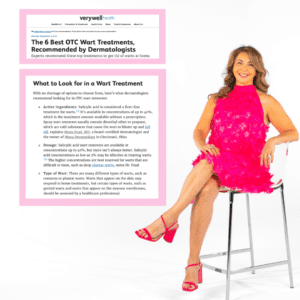6 Best Wart Treatments | Featured In Very Well Health
Dr. Mona Foad expands upon her insights shared in her recent Very Well Health feature, The 6 Best Wart Treatments.

What are warts and why do people get them?
Warts, or verruca, are small, grainy, bump-like growths that develop on the skin. They are especially common in areas like the hands and feet. Warts are caused by strains of the human papillomavirus (HPV). There are many different types of warts, including common warts, flat warts, plantar warts, filiform warts, and genital warts. All types of warts can vary in appearance and location.
- Common warts usually grow on the hands, fingers, and around the nails.
- Flat warts typically develop on the face, arms, or legs and are generally smaller and smoother.
- Plantar warts grow on the soles of the feet. These can be very painful while walking or standing.
- Filiform warts often appear on eyelids, lips, face, or neck.
- Genital warts are typically sexually transmitted and grow on and around the genital and anal areas.
Warts are transmitted through direct contact with the virus. This can occur through skin-to-skin contact with a person who has warts or by coming in contact with surfaces or objects that the virus has infected. Warts tend to be more prevalent among children and teenagers because their immune systems are still developing and, therefore, not strong enough to combat the virus. Additionally, some people are more susceptible to the virus because their genetic makeup and immune system are not as equipped to fight the virus when they come in contact with it. For example, it’s quite common to see warts on multiple siblings in the same family or children of parents who had warts as children.
Over-the-counter wart removal options
Two of the most recommended over-the-counter wart removal options include products with Salicylic Acid and Cryotherapy (freezing) products. Salicylic acid products come in a range of formulations, including liquids, gels, pads, and plasters, each designed to gradually dissolve the wart tissue. A popular OTC salicylic acid treatment that I like to recommend is either Compound W® One Step Pads or Dr. Scholl’s ClearAway Wart Remover. Both of these have salicylic acid in an easy-to-apply bandage and can be effective, non-painful ways to decrease the size and potentially remove warts.
OTC freezing products usually come in the form of a spray. By spraying the product directly onto the warts, the tissue is frozen and killed. These products commonly contain dimethyl ether or propane. These cold substances freeze the wart, causing it to turn into a blister, and ultimately fall off. For these types of products, I like to recommend Compound W Freeze Off or Dr. Scholl’s Freeze Away. Although this can be an effective way to remove smaller warts, it can be a more painful process than the salicylic acid options and generally does not work on larger warts or plantar warts, which go deeper into the skin.
In-office wart removal options
There are also in-office and prescription treatments for warts that might be more resistant or difficult to treat with OTC products. The most common treatment used by most dermatologists is cryotherapy, or freezing therapy, which involves using liquid nitrogen to freeze the wart. The liquid nitrogen used in an office setting is more effective than the OTC freezing options. Only a trained professional should use liquid nitrogen. With this treatment, the wart will blister and eventually fall off.
Another in-office procedure that we use to treat small warts is electrosurgery. We place a thin, needle-like tip on the wart that burns and kills the skin cells. Lasers can also be an effective way to treat warts. A pulse dye laser, such as a VBeam, uses a specific wavelength to target and shut off the blood supply that feeds the wart. The treated wart turns purple or black and falls off.
We can also use injections for stubborn and hard-to-treat warts. These can include 5-fluorouracil, bleomycin, and candida. Only a trained professional should perform these injections to minimize damage to the surrounding tissue. Although we can surgically cut out warts, this is not an effective treatment because they tend to recur at the edge of the excision site. Any method, no matter whether at home or in the office, may require several treatments to effectively remove the wart.
What products/ingredients are most effective at removing warts at home?
Over-the-counter (OTC) wart removal products usually include salicylic acid or freezing agents (cryotherapy) as the main ingredient. Most wart treatments focus on removing the top layers of skin where the warts reside. Warts and plantar warts are commonly treated with salicylic acid. It is slowly absorbed into the skin and causes the skin cells that contain the wart to shed and peel off. By softening the hardened skin of the wart, salicylic acid products effectively destroy the wart without causing significant damage to the surrounding skin. OTC salicylic acid products range in strength from 17% to 40% and can come in the forms of liquids, gels, and pads
Freezing agents, such as dimethyl ether, isobutane, or propane, work by quickly freezing and destroying both the wart tissue and a small area of normal skin around the wart, causing it to dry out and eventually fall off. These products can be effective in treating common warts. However, it is necessary to perform several treatments to remove the wart entirely. Plantar warts, on the other hand, go deeper into the skin of the foot and are harder to treat. For this reason, freezing agents may not be as successful on plantar warts.
